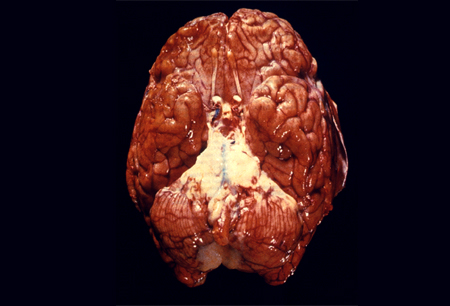Causative agents can vary according to age group, country, or region. Globally, the most common pathogens causing bacterial meningitis are Neisseria meningitidis and Streptococcus pneumoniae, accounting for 9.1% to 36.2% and 2.1% to 41.2% of bacterial meningitis cases, respectively.[26]Oordt-Speets AM, Bolijn R, van Hoorn RC, et al. Global etiology of bacterial meningitis: a systematic review and meta-analysis. PLoS One. 2018 Jun 11;13(6):e0198772.
https://journals.plos.org/plosone/article?id=10.1371/journal.pone.0198772
http://www.ncbi.nlm.nih.gov/pubmed/29889859?tool=bestpractice.com
In children, S pneumoniae is the most common pathogen, causing 22.5% (Europe) to 41.1% (Africa) of cases. In adults, S pneumoniae causes 9.6% (Western Pacific) to 75.2% (Africa) of cases.[26]Oordt-Speets AM, Bolijn R, van Hoorn RC, et al. Global etiology of bacterial meningitis: a systematic review and meta-analysis. PLoS One. 2018 Jun 11;13(6):e0198772.
https://journals.plos.org/plosone/article?id=10.1371/journal.pone.0198772
http://www.ncbi.nlm.nih.gov/pubmed/29889859?tool=bestpractice.com
[27]GBD 2019 Antimicrobial Resistance Collaborators. Global mortality associated with 33 bacterial pathogens in 2019: a systematic analysis for the Global Burden of Disease Study 2019. Lancet. 2022 Dec 17;400(10369):2221-48.
https://www.thelancet.com/journals/lancet/article/PIIS0140-6736(22)02185-7/fulltext
http://www.ncbi.nlm.nih.gov/pubmed/36423648?tool=bestpractice.com
N meningitidis serogroup B is the predominant cause of meningococcal meningitis in Europe, the US, and the Western Pacific, although with rates of serogroup Y increasing in the US since 2022.[24]Centers for Disease Control and Prevention. Meningococcal disease: meningococcal disease surveillance and trends. Apr 2025 [internet publication].
https://www.cdc.gov/meningococcal/php/surveillance/index.html
Meningococcal serogroups C and W are most common in most of Africa and Latin America. Serogroup Y cases mostly occur in Nordic countries.[26]Oordt-Speets AM, Bolijn R, van Hoorn RC, et al. Global etiology of bacterial meningitis: a systematic review and meta-analysis. PLoS One. 2018 Jun 11;13(6):e0198772.
https://journals.plos.org/plosone/article?id=10.1371/journal.pone.0198772
http://www.ncbi.nlm.nih.gov/pubmed/29889859?tool=bestpractice.com
The routine use of Haemophilus influenzae type b (Hib) and conjugate pneumococcal vaccines in the UK and other developed countries has markedly reduced the overall incidence of bacterial meningitis.[8]Brouwer MC, van de Beek D. Epidemiology of community-acquired bacterial meningitis. Curr Opin Infect Dis. 2018 Feb;31(1):78-84.
http://www.ncbi.nlm.nih.gov/pubmed/29176349?tool=bestpractice.com
[11]Castelblanco RL, Lee M, Hasbun R. Epidemiology of bacterial meningitis in the USA from 1997 to 2010: a population-based observational study. Lancet Infect Dis. 2014 Sep;14(9):813-9.
http://www.ncbi.nlm.nih.gov/pubmed/25104307?tool=bestpractice.com
[12]Hsu HE, Shutt KA, Moore MR, et al. Effect of pneumococcal conjugate vaccine on pneumococcal meningitis. N Engl J Med. 2009 Jan 15;360(3):244-56.
https://www.nejm.org/doi/full/10.1056/NEJMoa0800836
http://www.ncbi.nlm.nih.gov/pubmed/19144940?tool=bestpractice.com
[28]Schuchat A, Robinson K, Wenger JD, et al; Active Surveillance Team. Bacterial meningitis in the United States in 1995. N Engl J Med. 1997 Oct 2;337(14):970-6.
https://www.nejm.org/doi/full/10.1056/NEJM199710023371404
http://www.ncbi.nlm.nih.gov/pubmed/9395430?tool=bestpractice.com
[29]Centers for Disease Control and Prevention. Meningitis: clinical overview of fungal meningitis. Apr 2024 [internet publication].
https://www.cdc.gov/meningitis/hcp/clinical-overview-fm/?CDC_AAref_Val=https://www.cdc.gov/meningitis/clinical-resources.html
However, because of limited economic resources and poor living conditions, many developing countries continue to have high rates of disease.
In neonates, Escherichia coli and Streptococcus agalactiae (group B streptococci) are major causative agents of bacterial meningitis.[26]Oordt-Speets AM, Bolijn R, van Hoorn RC, et al. Global etiology of bacterial meningitis: a systematic review and meta-analysis. PLoS One. 2018 Jun 11;13(6):e0198772.
https://journals.plos.org/plosone/article?id=10.1371/journal.pone.0198772
http://www.ncbi.nlm.nih.gov/pubmed/29889859?tool=bestpractice.com
Group A streptococci (GAS), caused by Streptococcus pyogenes, has traditionally been believed to account for <2% of all cases of meningitis, but the incidence may be increasing.[30]Nielsen H, Storgaard M, Helweg-Larsen J, et al. Group A streptococcus meningitis in adults, Denmark. Emerg Infect Dis. 2023 Sep;29(9):1937-9.
https://wwwnc.cdc.gov/eid/article/29/9/23-0627_article
http://www.ncbi.nlm.nih.gov/pubmed/37478289?tool=bestpractice.com
[31]Schlech WF 3rd, Ward JI, Band JD, et al. Bacterial meningitis in the United States, 1978 through 1981. The National Bacterial Meningitis Surveillance Study. JAMA. 1985 Mar 22-29;253(12):1749-54.
https://jamanetwork.com/journals/jama/article-abstract/397525
http://www.ncbi.nlm.nih.gov/pubmed/3871869?tool=bestpractice.com
It is known for its high morbidity and mortality rate, especially in children.[32]Dou ZZ, Li W, Hu HL, et al. Group A streptococcal meningitis in children: a short case series and systematic review. Eur J Clin Microbiol Infect Dis. 2024 Aug;43(8):1517-31.
https://link.springer.com/article/10.1007/s10096-024-04863-2
http://www.ncbi.nlm.nih.gov/pubmed/38842766?tool=bestpractice.com
Gram-negative enteric bacilli (e.g., E coli , Serratia, Acinetobacter, Klebsiella, and Pseudomonas aeruginosa) are a rare cause of community-acquired bacterial meningitis but are an important cause of healthcare-associated ventriculitis and meningitis. Patients with both localized and disseminated strongyloidiasis (a chronic parasitic infection) are also predisposed to bacterial meningitis with enteric organisms such as Klebsiella pneumoniae (K pneumoniae), E coli, and Enterococcus spp.[33]Al-Hasan MN, McCormick M, Ribes JA. Invasive enteric infections in hospitalized patients with underlying strongyloidiasis. Am J Clin Pathol. 2007 Oct;128(4):622-7.
http://www.ncbi.nlm.nih.gov/pubmed/17875514?tool=bestpractice.com
[34]Bouadma L, Schortgen F, Thomas R, et al. Adults with spontaneous aerobic Gram-negative bacillary meningitis admitted to the intensive care unit. Clin Microbiol Infect. 2006 Mar;12(3):287-90.
https://www.clinicalmicrobiologyandinfection.com/article/S1198-743X(14)63924-0/fulltext
http://www.ncbi.nlm.nih.gov/pubmed/16451418?tool=bestpractice.com
Listeria monocytogenes can cause bacterial meningitis in patients using immunosuppressive drugs, in people who misuse alcohol, in neonates, in patients ages older than 50 years, and in patients with diabetes.[35]Koopmans MM, Brouwer MC, Bijlsma MW, et al. Listeria monocytogenes sequence type 6 and increased rate of unfavorable outcome in meningitis: epidemiologic cohort study. Clin Infect Dis. 2013 Jul;57(2):247-53.
https://academic.oup.com/cid/article/57/2/247/314829
http://www.ncbi.nlm.nih.gov/pubmed/23592828?tool=bestpractice.com
[36]van Veen KE, Brouwer MC, van der Ende A, et al. Bacterial meningitis in diabetes patients: a population-based prospective study. Sci Rep. 2016 Nov 15;6:36996.
https://www.ncbi.nlm.nih.gov/pmc/articles/PMC5109544
http://www.ncbi.nlm.nih.gov/pubmed/27845429?tool=bestpractice.com
Zoonotic causes of bacterial meningitis are rare, but important to consider when there is a history of exposure to animals. Streptococcus suis, most prevalent in Southeast Asia, is associated with raw pork meat and pig farming. Other zoonotic pathogens include Capnocytophaga canimorsus (associated with dogs), Campylobacter fetus (cattle), and Streptococcus equi (horses).[37]van Samkar A, Brouwer MC, Schultsz C, et al. Capnocytophaga canimorsus meningitis: three cases and a review of the literature. Zoonoses Public Health. 2016 Sep;63(6):442-8.
http://www.ncbi.nlm.nih.gov/pubmed/26693951?tool=bestpractice.com
[38]van Samkar A, Brouwer MC, van der Ende A, et al. Streptococcus equi meningitis. Clin Microbiol Infect. 2016 Jan;22(1):e3-4.
https://www.clinicalmicrobiologyandinfection.com/article/S1198-743X(15)00818-6/fulltext
http://www.ncbi.nlm.nih.gov/pubmed/26369601?tool=bestpractice.com
[39]van Samkar A, Brouwer MC, van der Ende A, et al. Campylobacter fetus meningitis in adults: report of 2 cases and review of the literature. Medicine (Baltimore). 2016 Feb;95(8):e2858.
https://www.ncbi.nlm.nih.gov/pmc/articles/PMC4779013
http://www.ncbi.nlm.nih.gov/pubmed/26937916?tool=bestpractice.com

